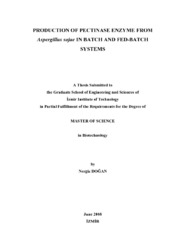Please use this identifier to cite or link to this item:
https://hdl.handle.net/11147/3033Full metadata record
| DC Field | Value | Language |
|---|---|---|
| dc.contributor.advisor | Tarı, Canan | en |
| dc.contributor.author | Doğan, Nergiz | - |
| dc.date.accessioned | 2014-07-22T13:50:45Z | - |
| dc.date.available | 2014-07-22T13:50:45Z | - |
| dc.date.issued | 2008 | en |
| dc.identifier.uri | http://hdl.handle.net/11147/3033 | - |
| dc.description | Thesis (Master)--Izmir Institute of Technology, Biotechnology, Izmir, 2008 | en |
| dc.description | Includes bibliographical references (leaves: 57-60) | en |
| dc.description | Text in English; Abstract: Turkish and English | en |
| dc.description | x, 74 leaves | en |
| dc.description.abstract | Commercial preparations of pectinases derived from fungi are well known to have high biotechnological value in the industry. For this purpose, polymethylgalacturonase (PMG) and polygalacturonase (PG) were produced with high productivities by Aspergillus sojae ATCC 20235 by using low cost carbon (Maltrin) and nitrogen (Corn Steep Liquor, CSL) sources. There is no literature report to best of our knowledge on the fed-batch production, purification and characterization of polygalacturonase using this microorganism.In this study batch fermentation was carried out in order to obtain the crude PG and to establish a baseline for the forth coming fed-batch experiments. The crude PG was partially purified using three-phase partitioning as an emerging bioseparation technique and characterized with respect to its biochemical and thermal properties. These studies showed that this enzyme holds a great potential to be a good candidate for various industrial applications. To optimize fed-batch fermentation conditions, response surface methodology (RSM) was performed using face-centered central composite design. As a result, maximum PG activity (20.61 U/ml) and maximum biomass (34.23 g/l) were obtained at high maltrin (150 g/l) and high CSL (10 g/l) concentrations when the repeated feeding was done at 48th and 72nd hours. Maximum PMG activity (16.76 U/ml) was also achieved at higher maltrin and higher CSL concentrations at a feeding time of 72nd hours. Fed-batch fermentation has been successfully used to increase PG (33.74%) and PMG (23.96%) activities from Aspergillus sojae. Finally, agar diffusion method was adapted as a rapid method for the selection of high pectinase producer in the strain improvement study. | en |
| dc.language.iso | en | en_US |
| dc.publisher | Izmir Institute of Technology | en |
| dc.rights | info:eu-repo/semantics/openAccess | en_US |
| dc.subject.lcc | TP248.27.F86 D65 2008 | en |
| dc.subject.lcsh | Fungi--Biotechnology | en |
| dc.subject.lcsh | Polygalacturonase | en |
| dc.subject.lcsh | Aspergillus--Biotechnology | en |
| dc.title | Production of pectinase enzyme from aspergillus sojae batch and fed-batch systems | en_US |
| dc.type | Master Thesis | en_US |
| dc.institutionauthor | Doğan, Nergiz | - |
| dc.department | Thesis (Master)--İzmir Institute of Technology, Bioengineering | en_US |
| dc.relation.publicationcategory | Tez | en_US |
| item.fulltext | With Fulltext | - |
| item.grantfulltext | open | - |
| item.languageiso639-1 | en | - |
| item.openairecristype | http://purl.org/coar/resource_type/c_18cf | - |
| item.cerifentitytype | Publications | - |
| item.openairetype | Master Thesis | - |
| Appears in Collections: | Master Degree / Yüksek Lisans Tezleri | |
Files in This Item:
| File | Description | Size | Format | |
|---|---|---|---|---|
| T000726.pdf | MasterThesis | 1.09 MB | Adobe PDF |  View/Open |
CORE Recommender
Page view(s)
132
checked on Nov 18, 2024
Download(s)
90
checked on Nov 18, 2024
Google ScholarTM
Check
Items in GCRIS Repository are protected by copyright, with all rights reserved, unless otherwise indicated.